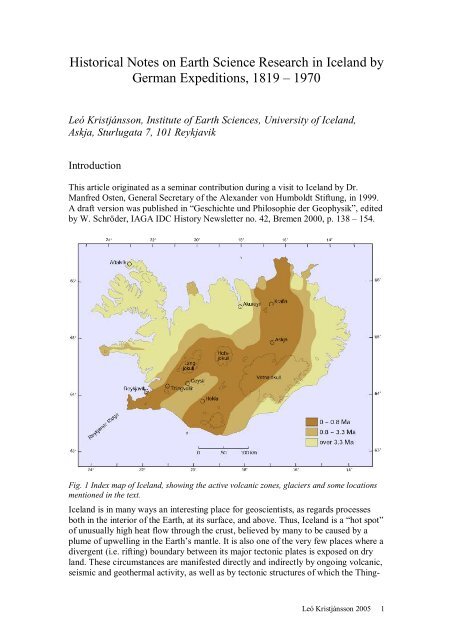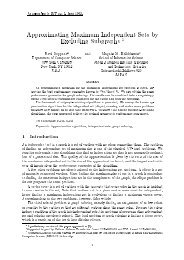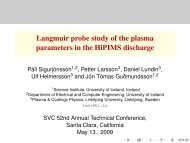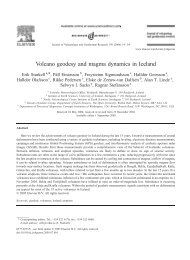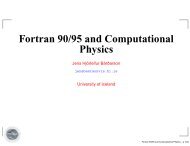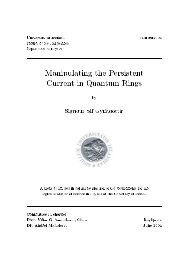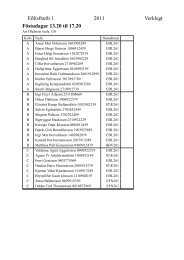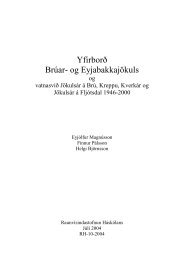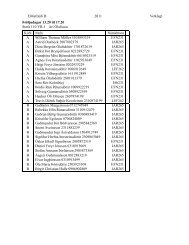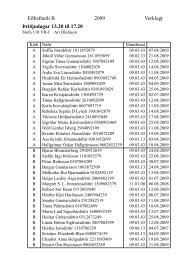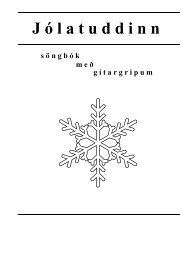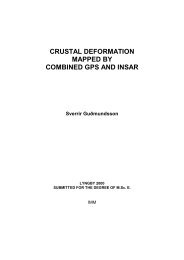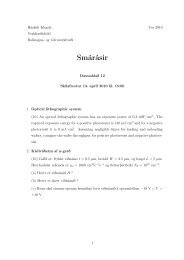Historical Notes on Earth Science Research in Iceland by German ...
Historical Notes on Earth Science Research in Iceland by German ...
Historical Notes on Earth Science Research in Iceland by German ...
You also want an ePaper? Increase the reach of your titles
YUMPU automatically turns print PDFs into web optimized ePapers that Google loves.
<str<strong>on</strong>g>Historical</str<strong>on</strong>g> <str<strong>on</strong>g>Notes</str<strong>on</strong>g> <strong>on</strong> <strong>Earth</strong> <strong>Science</strong> <strong>Research</strong> <strong>in</strong> <strong>Iceland</strong> <strong>by</strong><strong>German</strong> Expediti<strong>on</strong>s, 1819 – 1970Leó Kristjánss<strong>on</strong>, Institute of <strong>Earth</strong> <strong>Science</strong>s, University of <strong>Iceland</strong>,Askja, Sturlugata 7, 101 ReykjavikIntroducti<strong>on</strong>This article orig<strong>in</strong>ated as a sem<strong>in</strong>ar c<strong>on</strong>tributi<strong>on</strong> dur<strong>in</strong>g a visit to <strong>Iceland</strong> <strong>by</strong> Dr.Manfred Osten, General Secretary of the Alexander v<strong>on</strong> Humboldt Stiftung, <strong>in</strong> 1999.A draft versi<strong>on</strong> was published <strong>in</strong> “Geschichte und Philosophie der Geophysik”, edited<strong>by</strong> W. Schröder, IAGA IDC History Newsletter no. 42, Bremen 2000, p. 138 – 154.Fig. 1 Index map of <strong>Iceland</strong>, show<strong>in</strong>g the active volcanic z<strong>on</strong>es, glaciers and some locati<strong>on</strong>smenti<strong>on</strong>ed <strong>in</strong> the text.<strong>Iceland</strong> is <strong>in</strong> many ways an <strong>in</strong>terest<strong>in</strong>g place for geoscientists, as regards processesboth <strong>in</strong> the <strong>in</strong>terior of the <strong>Earth</strong>, at its surface, and above. Thus, <strong>Iceland</strong> is a “hot spot”of unusually high heat flow through the crust, believed <strong>by</strong> many to be caused <strong>by</strong> aplume of upwell<strong>in</strong>g <strong>in</strong> the <strong>Earth</strong>’s mantle. It is also <strong>on</strong>e of the very few places where adivergent (i.e. rift<strong>in</strong>g) boundary between its major tect<strong>on</strong>ic plates is exposed <strong>on</strong> dryland. These circumstances are manifested directly and <strong>in</strong>directly <strong>by</strong> <strong>on</strong>go<strong>in</strong>g volcanic,seismic and geothermal activity, as well as <strong>by</strong> tect<strong>on</strong>ic structures of which the Th<strong>in</strong>g-Leó Kristjánss<strong>on</strong> 2005 1
vellir graben is probably the best known. The volcanism has left a well-exposed pileof (mostly subaerial) basalt lavas, <strong>in</strong>tercalated <strong>by</strong> sediments which c<strong>on</strong>ta<strong>in</strong> plant andanimal fossils <strong>in</strong>dicat<strong>in</strong>g the climate changes dur<strong>in</strong>g the last 15 milli<strong>on</strong> years. Otherproducts of the volcanism <strong>in</strong>clude tephra layers, acidic rocks, <strong>in</strong>trusi<strong>on</strong>s of varioustypes, and sec<strong>on</strong>dary m<strong>in</strong>erals. The island has the largest glaciers <strong>in</strong> Europe,accompanied <strong>by</strong> very active geomorphological processes. Warm and cold currentsmeet <strong>in</strong> the ocean around <strong>Iceland</strong>, and the resultant vertical mix<strong>in</strong>g causes greatbiological productivity. Similarly, temperate and Arctic air masses <strong>in</strong>teract over thenortheastern Atlantic. And f<strong>in</strong>ally, <strong>Iceland</strong> happens to lie <strong>in</strong> the auroral z<strong>on</strong>e whichmakes it a good locati<strong>on</strong> for study<strong>in</strong>g phenomena <strong>in</strong> the i<strong>on</strong>osphere.In the 18 th century, several learned pers<strong>on</strong>s were sent to <strong>Iceland</strong> <strong>by</strong> the authoritiesresid<strong>in</strong>g <strong>in</strong> Copenhagen. Their task was to carry out geodetic and hydrographicsurveys, assess the island’s natural resources and vulnerabilities, and advise <strong>on</strong> waysto improve the lot of its <strong>in</strong>habitants. We may assume that reports from these pers<strong>on</strong>sas well as accounts (often quite <strong>in</strong>accurate and fanciful) <strong>by</strong> merchants and others ledto visits <strong>by</strong> scientists from Northern European countries <strong>in</strong> the late 18 th century. Thepresent paper briefly menti<strong>on</strong>s a number of <strong>German</strong> geologists and geophysicists whocarried out geoscience research <strong>in</strong> <strong>Iceland</strong> <strong>in</strong> the period 1819 – 1970, and some of theresult<strong>in</strong>g publicati<strong>on</strong>s. No complete data base of such expediti<strong>on</strong>s or their publishedresults exists <strong>in</strong> <strong>Iceland</strong>, and these results are scattered very widely through thescientific literature. This review is therefore pieced together from various sources, andit may leave out works of importance which have not reached the present author’sattenti<strong>on</strong>. Lists of some additi<strong>on</strong>al publicati<strong>on</strong>s are available from the author. Mostuseful have been the extensive accounts of early research <strong>by</strong> Th. Thoroddsen (1902 –04), a partial bibliography of foreign literature <strong>on</strong> <strong>Iceland</strong> <strong>by</strong> H. Sigurðss<strong>on</strong> (1991), apaper <strong>by</strong> M. Schwarzbach (1983) and the 19-volume “Catalogue of Scientific Papers”of the 19 th century published <strong>by</strong> the Royal Society of L<strong>on</strong>d<strong>on</strong>.It should be noted that there are important aspects of<strong>German</strong> scientific research related to <strong>Iceland</strong> which arenot given much attenti<strong>on</strong> <strong>in</strong> the present compilati<strong>on</strong>.Am<strong>on</strong>g them are laboratory observati<strong>on</strong>s <strong>on</strong> samplesof rocks, m<strong>in</strong>erals and geothermal fluids brought from<strong>Iceland</strong>. However, two early examples of suchresearch will be menti<strong>on</strong>ed here, <strong>on</strong>e be<strong>in</strong>g the first<strong>German</strong> paper <strong>on</strong> chemical analysis of <strong>Iceland</strong>icm<strong>in</strong>eral materials, written <strong>by</strong> M.H. Klaproth (1799), api<strong>on</strong>eer <strong>in</strong> m<strong>in</strong>eralogical chemistry. The otherpublicati<strong>on</strong> <strong>on</strong> m<strong>in</strong>eral samples c<strong>on</strong>cerns the zeoliteepistilbite (Rose 1826); this is possibly the <strong>on</strong>ly<strong>in</strong>stance of a m<strong>in</strong>eral hav<strong>in</strong>g been first identifiedand described <strong>in</strong> a specimen from <strong>Iceland</strong> (Fig. 2). Fig. 2. Draw<strong>in</strong>g <strong>by</strong> the famousIt may be remarked <strong>in</strong> this c<strong>on</strong>text that <strong>Iceland</strong> spar, m<strong>in</strong>eralogist G. Rose (1826) of aa transparent variety of calcite exported from a crystal of epistilbite, <strong>in</strong> a paperquarry <strong>in</strong> Eastern <strong>Iceland</strong>, was of c<strong>on</strong>siderable value describ<strong>in</strong>g this zeolite (hydratedto segments of <strong>German</strong> optical science, chemistry alterati<strong>on</strong> m<strong>in</strong>eral) for the firstand <strong>in</strong>dustry <strong>in</strong> the period 1830 – 1930 at least: see time. For many decades, epistilbitewas <strong>on</strong>ly very rarely encounteredwww.raunvis.hi.is/~leo/spar.htmloutside <strong>Iceland</strong>.Leó Kristjánss<strong>on</strong> 2005 2
1819 – 1849 Geology, geochemistry“In der deutschen Wissenschaft hat Islands Naturwelt stets weitgehende Beachtunggefunden” (Spethmann 1930). Am<strong>on</strong>g the first people who visited <strong>Iceland</strong> specificallyto study its geology were two <strong>German</strong>s, the self-educated m<strong>in</strong>eralogist JohannesMenge <strong>in</strong> 1819 and Otto Krug v<strong>on</strong> Nidda <strong>in</strong> 1833. Both travelled widely around theisland and wrote papers c<strong>on</strong>ta<strong>in</strong><strong>in</strong>g valuable observati<strong>on</strong>s (e.g. Menge 1820; Krug v<strong>on</strong>Nidda 1834, 1836) although Thoroddsen (1902 – 04) c<strong>on</strong>siders their geological ideasto have been somewhat unrealistic. The year 1819 is also significant because twopublicati<strong>on</strong>s appeared <strong>in</strong> <strong>German</strong>y describ<strong>in</strong>g various geological phenomena androcks from <strong>Iceland</strong>: <strong>on</strong>e is a book <strong>by</strong> G. Garlieb (1819), and the other is a paper <strong>by</strong> E.Vargas de Bedemar (1819), a <strong>German</strong> scientist <strong>in</strong> charge of the m<strong>in</strong>eral collecti<strong>on</strong> ofthe Crown Pr<strong>in</strong>ce of Denmark. As far as I know neither of them visited <strong>Iceland</strong>, sounderstandably their accounts are not very accurate. F.A. Thienemann (1824 – 27), a<strong>German</strong> medical doctor and ornithologist, wrote a book <strong>on</strong> his travels <strong>in</strong> <strong>Iceland</strong> <strong>in</strong>1820 – 21 which <strong>in</strong>cludes various observati<strong>on</strong>s of geological <strong>in</strong>terest.In late 1845 there was a large erupti<strong>on</strong> <strong>in</strong> the volcano Hekla, with tephra from its<strong>in</strong>itial phase be<strong>in</strong>g carried <strong>by</strong> w<strong>in</strong>ds as far as the Orkneys. This tephra was studied <strong>by</strong>Ehrenberg (e.g. 1846) who previously had <strong>in</strong>vestigated subfossil microfauna brought<strong>by</strong> the above-menti<strong>on</strong>ed F.A. Thienemann from <strong>Iceland</strong>. In the summer of 1846, anexpediti<strong>on</strong> came from Europe to study Hekla and other geological phenomena, withthe generous support of the K<strong>in</strong>g ofDenmark and <strong>Iceland</strong>, ChristianVIII. It <strong>in</strong>cluded the famous chemistRobert Bunsen and the geologistWolfgang Sartorius v<strong>on</strong> Waltershausen.Many important publicati<strong>on</strong>sresulted from this expediti<strong>on</strong>,regard<strong>in</strong>g the geology of <strong>Iceland</strong> aswell as the m<strong>in</strong>eralogy of basalts,generati<strong>on</strong> of palag<strong>on</strong>ite tuffs, andhydrothermal alterati<strong>on</strong> effects(e.g. Sartorius v<strong>on</strong> Waltershausen1847, 1853; Bunsen 1847a, 1851;Genth 1848; Rammelsberg 1849).Bunsen (1847a) suggested a mechanismfor the erupti<strong>on</strong>s of the largehot spr<strong>in</strong>g <strong>in</strong> Southern <strong>Iceland</strong>which has given its name Geysir toerupt<strong>in</strong>g hot spr<strong>in</strong>gs everywhere.Bunsen’s paper was for a l<strong>on</strong>g timethe best known of the various theoriesof geyser acti<strong>on</strong>, and it <strong>in</strong>spiredothers to study this phenomen<strong>on</strong>(see Fig. 3). Another tra<strong>in</strong> ofdevelopments result<strong>in</strong>g <strong>in</strong> part fromBunsen’s <strong>Iceland</strong> visit, relates to the factthat after this visit he made some of thefirst-ever laboratory observati<strong>on</strong>s <strong>on</strong> theFig. 3. Test<strong>in</strong>g of <strong>on</strong>e of the many hypothesesof geyser acti<strong>on</strong>, <strong>in</strong>spired <strong>by</strong> the work of R.Bunsen and others <strong>on</strong> erupt<strong>in</strong>g hot spr<strong>in</strong>gs <strong>in</strong><strong>Iceland</strong> from Andreae 1893).Leó Kristjánss<strong>on</strong> 2005 3
color of water; a paper (Bunsen 1849) where he refers to the blueness of <strong>Iceland</strong>’s hotspr<strong>in</strong>gs and glaciers, prompted am<strong>on</strong>g other th<strong>in</strong>gs far-reach<strong>in</strong>g research <strong>by</strong> theIrishman J. Tyndall <strong>on</strong> scatter<strong>in</strong>g of light <strong>by</strong> small particles.1850 – 1900 Geology, pale<strong>on</strong>tology, m<strong>in</strong>eralogy, geomorphologyGustav Georg W<strong>in</strong>kler came to <strong>Iceland</strong> <strong>in</strong> 1858 al<strong>on</strong>g with the historian K<strong>on</strong>radMaurer whose account of their travels has <strong>on</strong>ly been published very recently (Maurer1997). W<strong>in</strong>kler wrote two books <strong>on</strong> his observati<strong>on</strong>s <strong>in</strong> <strong>Iceland</strong>, <strong>on</strong>e <strong>on</strong> geology(W<strong>in</strong>kler 1863) but his <strong>in</strong>terpretati<strong>on</strong>s were based <strong>on</strong> outdated c<strong>on</strong>cepts such asNeptunism.The next <strong>German</strong> geological visitor was them<strong>in</strong>eralogist Ferd<strong>in</strong>and Zirkel, who travelled <strong>in</strong><strong>Iceland</strong> <strong>in</strong> 1860 al<strong>on</strong>g with William Th. Preyer,later professor of physiology (Preyer and Zirkel1862). Zirkel wrote his doctoral thesis <strong>on</strong> thegeology of <strong>Iceland</strong> (Zirkel 1861), and <strong>in</strong> hispi<strong>on</strong>eer<strong>in</strong>g works <strong>on</strong> microscopical petrography(Zirkel 1863, etc.) he describes many th<strong>in</strong>secti<strong>on</strong>s of <strong>Iceland</strong>ic igneous rocks (Fig. 4).Zirkel (1875), Gerhard vom Rath and otherswrote papers <strong>on</strong> tephra material from thevolcano Askja <strong>in</strong> <strong>Iceland</strong>, which fell <strong>in</strong> NorthernEurope <strong>in</strong> March 1875. Later petrographers suchas Harry Rosenbusch, Justus Roth, L. PaulSchirlitz (1882) and Albrecht Penck (1879) also<strong>in</strong>cluded <strong>Iceland</strong>ic material (at least partlyprovided <strong>by</strong> Zirkel) <strong>in</strong> their papers and books.Penck, <strong>by</strong> the way, is best known for his laterwork <strong>on</strong> landforms and Alp<strong>in</strong>e glaciati<strong>on</strong>s.Fig. 4. An illustrati<strong>on</strong> <strong>by</strong> F. Zirkel(1863) show<strong>in</strong>g sec<strong>on</strong>dary m<strong>in</strong>erals<strong>in</strong> a microscope slide from <strong>Iceland</strong>icbasalt. Zirkel was <strong>on</strong>e ofthe pi<strong>on</strong>eers of microscopicalpetrography.Valuable <strong>in</strong>vestigati<strong>on</strong>s of Miocene-Pliocene plant fossils <strong>in</strong> <strong>Iceland</strong> <strong>in</strong>itiated <strong>by</strong> theSwiss pale<strong>on</strong>tologist Oswald Heer around 1860 (<strong>on</strong> material collected <strong>by</strong> W<strong>in</strong>kler andothers) were c<strong>on</strong>t<strong>in</strong>ued e.g. <strong>by</strong> Paul W<strong>in</strong>disch (1885). K<strong>on</strong>rad Keilhack travelled <strong>in</strong><strong>Iceland</strong> <strong>in</strong> 1883 with Carl W. Schmidt who studied rhyolites (Schmidt 1885).Keilhack carried out research <strong>on</strong> geothermal activity and especially <strong>on</strong> glacialphenomena, which he found helpful for understand<strong>in</strong>g the orig<strong>in</strong> of Quaternarydeposits <strong>in</strong> Northern <strong>German</strong>y. Keilhack’s varied writ<strong>in</strong>gs <strong>on</strong> <strong>Iceland</strong> <strong>in</strong>clude a book(Keilhack 1885), a geological map of the island with explanati<strong>on</strong>s (Keilhack 1886a), adescripti<strong>on</strong> of vegetati<strong>on</strong> around hot spr<strong>in</strong>gs (Keilhack 1886b) and writ<strong>in</strong>gs aboutglacial deposits (e.g. Keilhack 1883) where he <strong>in</strong>troduced the <strong>Iceland</strong>ic term “sandur”<strong>in</strong>to the European literature.1901 – 1914 Geology, volcanology, glaciersSeveral <strong>German</strong> scientists made notable c<strong>on</strong>tributi<strong>on</strong>s to the geology of <strong>Iceland</strong>follow<strong>in</strong>g their research there <strong>in</strong> the first decade of the century. In this period Waltherv<strong>on</strong> Knebel (who was <strong>on</strong>e of the first geoscientists to study calderas) travelled <strong>in</strong><strong>Iceland</strong> and wrote papers <strong>on</strong> both volcanic and glacial phenomena (e.g. v<strong>on</strong> KnebelLeó Kristjánss<strong>on</strong> 2005 4
1906, 1907, see Fig. 5) A book describ<strong>in</strong>ghis observati<strong>on</strong>s was completed <strong>by</strong>Hans Reck (v<strong>on</strong> Knebel 1912) after v<strong>on</strong>Knebel and the pa<strong>in</strong>ter Max Rudlofftragically perished at the Askja calderalake <strong>in</strong> North <strong>Iceland</strong> <strong>in</strong> 1907. Reckhimself wrote a book <strong>on</strong> volcanic erupti<strong>on</strong>s(Reck 1910a) as well as over adozen papers <strong>on</strong> volcanic features (e.g.Reck 1910b) and late Quaternary toRecent glacial deposits (e.g. Reck 1911)<strong>in</strong> <strong>Iceland</strong>. Karl Schneider (1907) fromBohemia, Karl Sapper (1908, 1909),Hans Spethmann (1909, 1912, 1913,1930, etc.), Max Trautz (1914), Mauricev<strong>on</strong> Komorowicz (1912) and LudwigWunder (1912) also <strong>in</strong>vestigated volcanoesand glaciers. Schneider (1913) Fig. 5. Map <strong>by</strong> W. v<strong>on</strong> Knebel (1905) of Quaternaryvolcanic and glacial formati<strong>on</strong>s at theadditi<strong>on</strong>ally discussed some geothermalmanifestati<strong>on</strong>s <strong>in</strong> <strong>Iceland</strong>. In geophysics, southeastern part of the Langjökull glacier.an expediti<strong>on</strong> arrived to make geomagneticmeasurements dur<strong>in</strong>g the 1910 approach of Halley’s Comet (Angenheister andAnsel 1912).Am<strong>on</strong>g travellers <strong>in</strong>terested <strong>in</strong> both geological and geographical aspects of <strong>Iceland</strong>were Carl Küchler who published three books and several papers <strong>on</strong> <strong>Iceland</strong> (Küchler1909, 1911, and others), and He<strong>in</strong>rich Erkes who visited <strong>Iceland</strong> at least eight times to1926. Erkes wrote over 30 papers and newspaper articles <strong>on</strong> a wide variety of topics(e.g. Erkes 1909, 1911) and he c<strong>on</strong>tributed much descriptive material to the periodical“Mitteilungen der Islandfreunde” which was published <strong>in</strong> Jena <strong>in</strong> 1913 – 36.In 1912, an expediti<strong>on</strong> led <strong>by</strong> Alfred Wegener travelled from Akureyri <strong>in</strong> centralNorthern <strong>Iceland</strong> to the Vatnajökull glacier (Koch and Wegener 1930), <strong>in</strong> preparati<strong>on</strong>for their cross<strong>in</strong>g of Greenland <strong>in</strong> 1912 – 13. Wegener (1914) published a short paper<strong>on</strong> dust cycl<strong>on</strong>es which he had observed <strong>in</strong> <strong>Iceland</strong>, but the island’s geology did notcome to play a part <strong>in</strong> his famous c<strong>on</strong>cept of c<strong>on</strong>t<strong>in</strong>ental drift.1920 – 1940 Glaciers, tect<strong>on</strong>icsThe c<strong>on</strong>t<strong>in</strong>u<strong>in</strong>g <strong>in</strong>terest <strong>in</strong> <strong>Iceland</strong>’s nature and culture <strong>in</strong> this period is reflected <strong>in</strong> atwo-volume book <strong>on</strong> “Deutsche Islandforschung 1930”, edited <strong>by</strong> Walter H. Vogt andHans Spethmann. In the late 1920’s and the 1930’s several <strong>German</strong> and Austrianscientists explored <strong>Iceland</strong>, pay<strong>in</strong>g special attenti<strong>on</strong> to glaciers and their surround<strong>in</strong>gs.These <strong>in</strong>cluded Karl Schmid and Helmut Verleger who visited the site of a 1934volcanic erupti<strong>on</strong> <strong>in</strong> the Vatnajökull glacier, Emmy M. Todtmann, Ernst Herrmann,Wolfgang Oett<strong>in</strong>g, Walter Iwan, and Paul Woldstedt. Am<strong>on</strong>g publicati<strong>on</strong>s of thesescientists are Schmid (1954), Verleger (1934), Todtmann (1932), Oett<strong>in</strong>g (1930),Iwan (1935, 1937), Herrmann (1928 – 29) and Woldstedt (1939). K<strong>on</strong>rad Keilhack(see above) re-visited <strong>Iceland</strong> <strong>in</strong> 1924 <strong>in</strong> c<strong>on</strong>necti<strong>on</strong> with a gold-prospect<strong>in</strong>g projectLeó Kristjánss<strong>on</strong> 2005 5
and wrote further papers, <strong>on</strong>e of them c<strong>on</strong>ta<strong>in</strong><strong>in</strong>g the first detailed map of the geologyof the Reykjavík area (Keilhack 1925).Fig. 6. A detailed cross-secti<strong>on</strong> of <strong>on</strong>e of the large tect<strong>on</strong>ic fissure systems<strong>in</strong> Northeastern <strong>Iceland</strong>, studied <strong>by</strong> O. Niemczyk’s group <strong>in</strong> 1938 (adaptedfrom Niemczyk 1943).A major new development was an expediti<strong>on</strong> <strong>in</strong> 1938 to study active tect<strong>on</strong>ics of thevolcanic z<strong>on</strong>e <strong>in</strong> Southwestern and Northeastern <strong>Iceland</strong>. This project was probably<strong>in</strong>spired <strong>by</strong> the volcanological research of some of the authors previously menti<strong>on</strong>edas well as <strong>by</strong> the work of Danish and Swiss geologists (such as N. Nielsen, R. S<strong>on</strong>derand A. Rittmann) <strong>in</strong> <strong>Iceland</strong>. It resulted <strong>in</strong> a book (Niemczyk 1943) which <strong>in</strong>cludedchapters <strong>on</strong> tect<strong>on</strong>ic moti<strong>on</strong>s <strong>in</strong> <strong>Iceland</strong> <strong>by</strong> Ferd<strong>in</strong>and Bernauer (who is better knownfor his work <strong>in</strong> m<strong>in</strong>eralogy and optics), <strong>on</strong> precise geodetic measurements acrossfissure z<strong>on</strong>es (Fig. 6) <strong>by</strong> Oskar Niemczyk and E. Emschermann, and <strong>on</strong> gravityobservati<strong>on</strong>s <strong>by</strong> E. Ansel and Alfred Schleusener. The geodetic work was alsopublished separately (e.g. Niemczyk and Emschermann 1940), and Bernauer wroteseveral papers <strong>on</strong> related topics (e.g. Bernauer 1937, 1939a).It was <strong>in</strong>tended to c<strong>on</strong>t<strong>in</strong>ue the tect<strong>on</strong>ics research, but World War II and subsequentchanges <strong>in</strong> Europe <strong>in</strong>tervened. The <strong>German</strong> group had observed <strong>in</strong> <strong>Iceland</strong> importantc<strong>on</strong>sequences of the process of c<strong>on</strong>t<strong>in</strong>ental drift <strong>by</strong> sea floor spread<strong>in</strong>g at mid-oceanridges (see Bernauer 1939b) but as is well known, the significance of this process wasnot fully appreciated for the next few decades.1950 – 1970 Geology, geophysicsEmmy Todtmann c<strong>on</strong>t<strong>in</strong>ued her work <strong>on</strong> periglacialphenomena <strong>in</strong> the 1950’s (e.g. Todtmann 1957);otherwise, not much research <strong>on</strong> <strong>Iceland</strong>ic glaciers andglacial geology seems to have been undertaken <strong>by</strong><strong>German</strong> scientists <strong>in</strong> the period to 1970.Mart<strong>in</strong> Schwarzbach’s group from Köln wrote severalpapers <strong>on</strong> various aspects of <strong>Iceland</strong>ic geology from 1955to after 1970, largely c<strong>on</strong>nected with fossil-bear<strong>in</strong>g<strong>in</strong>terbasaltic sediments (e.g. Schwarzbach 1955,Schwarzbach and Pflug 1957; Strauch 1963; Friedrich1966, see Fig. 7) as well as geological guide-books(Schwarzbach 1956 and later). Their best known c<strong>on</strong>-Fig. 7. A well-preserved leaffossil of about 12 milli<strong>on</strong>years age from Northwestern<strong>Iceland</strong> (draw<strong>in</strong>g fromFriedrich 1966).Leó Kristjánss<strong>on</strong> 2005 6
clusi<strong>on</strong> (Pflug 1959) may have been that pollen <strong>in</strong> the oldest sediments of Eastern andNorthwestern <strong>Iceland</strong> <strong>in</strong>dicated an Eocene or even older age, i.e. more than 50 milli<strong>on</strong>years. However, K-Ar radiometric age determ<strong>in</strong>ati<strong>on</strong>s published <strong>in</strong> 1966 – 68 showedthat the oldest exposed rocks <strong>in</strong> <strong>Iceland</strong> are <strong>on</strong>ly about 15 milli<strong>on</strong> years old.Papers <strong>by</strong> George P.L. Walker of L<strong>on</strong>d<strong>on</strong> (and later also <strong>by</strong> his students andassociates) <strong>on</strong> the stratigraphy, geochemical development, and tect<strong>on</strong>ics of Eastern<strong>Iceland</strong> began appear<strong>in</strong>g <strong>in</strong> 1959. Over the next decade this work truly revoluti<strong>on</strong>izedall th<strong>in</strong>k<strong>in</strong>g about the island’s geology, and paved the way for its understand<strong>in</strong>g <strong>in</strong>terms of a plate boundary/hot spot envir<strong>on</strong>ment. One paper <strong>on</strong> local stratigraphy <strong>in</strong>Northeastern <strong>Iceland</strong> appeared from the Köln group (Jux 1960) but otherwise theymissed tak<strong>in</strong>g part <strong>in</strong> the revoluti<strong>on</strong>. In fact, even <strong>Iceland</strong>ic geologists have been slowat follow<strong>in</strong>g up Walker’s accomplishments, and many parts of <strong>Iceland</strong> still rema<strong>in</strong> tobe mapped <strong>in</strong> any k<strong>in</strong>d of detail <strong>by</strong> earth scientists.Fig. 8. A precise geodetic triangulati<strong>on</strong> net across the fissure z<strong>on</strong>e atTh<strong>in</strong>gvellir, Southwestern <strong>Iceland</strong>, set up <strong>in</strong> 1967 (from Gerke 1967).The 1938 <strong>German</strong> geodetic and gravity work across the volcanic z<strong>on</strong>es was resumed(Fig. 8) <strong>in</strong> 1964 – 65 with much improved equipment (Gerke 1967, Schleusener andTorge 1971). No def<strong>in</strong>ite crustal extensi<strong>on</strong> had been found <strong>by</strong> the early 1970’s, butdur<strong>in</strong>g an episode of <strong>in</strong>tense activity <strong>in</strong> the Krafla volcanic center of Northeastern<strong>Iceland</strong> <strong>in</strong> 1975 – 84 it became apparent that the process of spread<strong>in</strong>g <strong>in</strong> the island isquite <strong>in</strong>termittent: at each volcanic center, quiescent <strong>in</strong>tervals of the order of centuriesmay pass between events when several meters of extensi<strong>on</strong> take place <strong>in</strong> a few years.Towards the end of the 1960’s several new earth-science researchers from <strong>German</strong>ywere beg<strong>in</strong>n<strong>in</strong>g work <strong>in</strong> <strong>Iceland</strong>, e.g. N. Petersen and his colleagues from München(ground magnetic surveys), K. Schäfer from Karlsruhe (volcanism, tect<strong>on</strong>ics) and H.Noll from Köln (volcanism, stratigraphy).Leó Kristjánss<strong>on</strong> 2005 7
<str<strong>on</strong>g>Notes</str<strong>on</strong>g> <strong>on</strong> meteorology and related studies, to 1938Already <strong>in</strong> the late 19 th century, European scientists looked to the NortheasternAtlantic Ocean <strong>in</strong> their efforts to understand the climate of the c<strong>on</strong>t<strong>in</strong>ent. Aerologicalexpediti<strong>on</strong>s from <strong>German</strong>y visited <strong>Iceland</strong> as early as 1907 (Hildebrandt 1907).Meteorological observati<strong>on</strong>s which were made <strong>in</strong> <strong>Iceland</strong> c<strong>on</strong>t<strong>in</strong>uously from 1845,<strong>in</strong>dicated am<strong>on</strong>g other th<strong>in</strong>gs that the atmospheric pressure was very variable <strong>in</strong> the<strong>Iceland</strong> area and that its annual mean there was quite low. It was postulated that thepositi<strong>on</strong> and <strong>in</strong>tensity of this pressure m<strong>in</strong>imum might <strong>in</strong>fluence the Europeanweather (see Drewes 1917; Wiese 1925) directly or through its effect <strong>on</strong> the GulfStream. Others po<strong>in</strong>ted out that due to the large annual pressure variati<strong>on</strong>s <strong>in</strong> the<strong>Iceland</strong> regi<strong>on</strong>, it might be termed a “center of acti<strong>on</strong>” for the climate (see Defant1917). Still other theories <strong>in</strong>volved the presence of the Greenland ice cap and itseffect <strong>on</strong> air masses, or the possibility of occasi<strong>on</strong>al large “outbreaks” of cold air fromthe Arctic which would <strong>in</strong>fluence the development of weather systems over theAtlantic. Observati<strong>on</strong>s <strong>in</strong> <strong>Iceland</strong> were therefore expected to be of value both forshort- and l<strong>on</strong>g-term forecast<strong>in</strong>g of the weather <strong>in</strong> <strong>German</strong>y.Fig. 9. Very str<strong>on</strong>g northerly w<strong>in</strong>ds <strong>in</strong> the upper troposphere, 9 to 13 km altitude,found <strong>by</strong> pilot ballo<strong>on</strong> observati<strong>on</strong>s <strong>in</strong> Adalvik, Northwestern <strong>Iceland</strong> <strong>in</strong> 1927(from Georgi 1950).By the mid-1920’s, the weather <strong>in</strong> the Northeastern Atlantic was also of <strong>in</strong>creas<strong>in</strong>g<strong>in</strong>terest due to the prospect of air transport between the c<strong>on</strong>t<strong>in</strong>ents <strong>by</strong> the northernroute. This prompted Johannes Georgi, an associate of Alfred Wegener, to studyupper atmosphere moti<strong>on</strong>s <strong>in</strong> the exposed locati<strong>on</strong> Adalvik <strong>in</strong> Northwestern <strong>Iceland</strong> <strong>in</strong>the summers of 1926 – 27 (see e.g. Dannmeyer and Georgi 1932). Dur<strong>in</strong>g this work,pilot ballo<strong>on</strong> observati<strong>on</strong>s revealed occasi<strong>on</strong>al very str<strong>on</strong>g w<strong>in</strong>ds at altitudes above 5km (Fig. 9). Georgi (e.g., 1928a,b) ascribed the str<strong>on</strong>g w<strong>in</strong>ds to the cold outbreaks justmenti<strong>on</strong>ed, but much later it was realized (see Georgi 1950) that his group may havebeen the first to observe the phenomen<strong>on</strong> now known as the circumpolar “jet stream”.The expediti<strong>on</strong> to Adalvik also made an <strong>in</strong>terest<strong>in</strong>g series of observati<strong>on</strong>s <strong>on</strong> ultravioletradiati<strong>on</strong> from the sky, later extended <strong>in</strong> Northern <strong>Iceland</strong> <strong>by</strong> a group from the<strong>German</strong> University <strong>in</strong> Prague (Fuchs and Langer 1938).Leó Kristjánss<strong>on</strong> 2005 8
At least partially <strong>in</strong> c<strong>on</strong>sequence of Georgi’s 1926 – 27 expediti<strong>on</strong>s, the researchvessel “Meteor” was sent to carry out meteorological and hydrographic studies <strong>in</strong> thewaters around <strong>Iceland</strong> <strong>in</strong> 1928 – 33 (Fig. 10, see Georgi 1932, Schulz 1934). Georgi’sresults were also followed up <strong>by</strong> observati<strong>on</strong>s from the Greenland ice cap <strong>in</strong> 1930 –31, <strong>in</strong> the last expediti<strong>on</strong> led <strong>by</strong> Wegener. Some of the research <strong>by</strong> “Meteor”, whichwas c<strong>on</strong>t<strong>in</strong>ued <strong>in</strong> two cruises <strong>in</strong> 1935 (Defant 1936) had c<strong>on</strong>necti<strong>on</strong>s withmeteorological projects <strong>in</strong> <strong>Iceland</strong> dur<strong>in</strong>g the Internati<strong>on</strong>al Polar Year 1932 – 33.C<strong>on</strong>clud<strong>in</strong>g remarksFig. 10. Tracks of the research ship “Meteor” <strong>in</strong> the waters around<strong>Iceland</strong>, 1928 – 33 (Schulz 1934).It may be seen from the above that <strong>German</strong> earth scientists have been active with<strong>in</strong>many fields of research <strong>in</strong> <strong>Iceland</strong> and the surround<strong>in</strong>g regi<strong>on</strong>. This account hashowever been quite limited <strong>in</strong> its scope, c<strong>on</strong>centrat<strong>in</strong>g <strong>on</strong> scientists who went to<strong>Iceland</strong> to make observati<strong>on</strong>s. Am<strong>on</strong>g categories of studies <strong>by</strong> <strong>German</strong>s relevant to<strong>Iceland</strong> which have not been treated here are e.g. purely geographical descripti<strong>on</strong>s,record<strong>in</strong>g of seismic waves from earthquakes <strong>in</strong> and around <strong>Iceland</strong> (beg<strong>in</strong>n<strong>in</strong>g <strong>in</strong>1896), and process<strong>in</strong>g of meteorological data from that regi<strong>on</strong>.After 1970, <strong>German</strong> geoscientists have participated <strong>in</strong> a number of research projects<strong>in</strong> the <strong>Iceland</strong> area, sometimes <strong>in</strong> a lead<strong>in</strong>g role. These projects <strong>in</strong>clude largeexplosi<strong>on</strong>-seismic and magnetotelluric studies, geodetic surveys, remote sens<strong>in</strong>g ofglaciers and geomorphological phenomena, and deep core drill<strong>in</strong>g <strong>in</strong>to the lava pile <strong>in</strong>1978, to name a few of the most c<strong>on</strong>spicuous <strong>on</strong>es. There have also been severalmar<strong>in</strong>e geophysical cruises <strong>in</strong> the area <strong>by</strong> research ships such as “Meteor” and“Komet”, beg<strong>in</strong>n<strong>in</strong>g <strong>in</strong> 1968 over the <strong>Iceland</strong>-Faeroe Ridge.<strong>Research</strong> <strong>by</strong> <strong>German</strong>s <strong>in</strong> <strong>Iceland</strong> is <strong>on</strong>ly <strong>on</strong>e aspect of the varied c<strong>on</strong>tacts between thetwo countries as regards earth science. Thus, several <strong>Iceland</strong>ers have lived <strong>in</strong><strong>German</strong>y at some time or another while study<strong>in</strong>g or carry<strong>in</strong>g out research <strong>in</strong> this field,the first <strong>on</strong>e be<strong>in</strong>g Thorvaldur Thoroddsen who stayed <strong>in</strong> Leipzig <strong>in</strong> 1884 – 85; theywere often supported <strong>by</strong> <strong>German</strong> fund<strong>in</strong>g agencies like the Alexander v<strong>on</strong> HumboldtStiftung. Many papers written <strong>by</strong> <strong>Iceland</strong>ic and other scientists <strong>on</strong> the geology ofLeó Kristjánss<strong>on</strong> 2005 9
<strong>Iceland</strong> have appeared <strong>in</strong> <strong>German</strong> learned journals (<strong>in</strong>clud<strong>in</strong>g <strong>in</strong> 1980 a volume of the“Journal of Geophysics” dedicated to <strong>Iceland</strong>), and so <strong>on</strong>.The populati<strong>on</strong> of <strong>Iceland</strong> itself is small and cannot susta<strong>in</strong> a high level of fund<strong>in</strong>gand manpower for research <strong>in</strong>to the geological history and current manifestati<strong>on</strong>s ofthe varied processes operat<strong>in</strong>g <strong>in</strong> this very active regi<strong>on</strong> of the <strong>Earth</strong> (cf. theIntroducti<strong>on</strong> above). The <strong>German</strong> research effort and its result<strong>in</strong>g c<strong>on</strong>tributi<strong>on</strong>s to ourknowledge <strong>in</strong> these fields have been of much value to <strong>Iceland</strong> and <strong>in</strong>ternati<strong>on</strong>alscience.ReferencesAndreae, A. (1893) Über die künstliche Nachahmung des Geysirphänomens. NeuesJahrbuch für M<strong>in</strong>eralogie, Geologie und Palä<strong>on</strong>tologie 1893(II), 1–25.Angenheister, G. and Ansel, A. (1912) Die Island-Expediti<strong>on</strong> im Frühjahr 1910.Nachrichten v<strong>on</strong> der königlichen Gesellschaft der Wissenschaften zu Gött<strong>in</strong>gen,mathematisch-physische Klasse 19, 43–111.Bernauer, F. (1937) Geschichtete Lava an isländischen Vulkanen. Zeitschrift derdeutschen geologischen Gesellschaft 89, 88–97.Bernauer, F. (1939a) Vulkanische und tekt<strong>on</strong>ische Spalten auf Island. Zeitschrift derdeutschen geologischen Gesellschaft 91, 405–420.Bernauer, F. (1939b) Island und die Frage der K<strong>on</strong>t<strong>in</strong>entalverschiebungen.Geologische Rundschau 30, 357–358.Bunsen, R. (1847a) Ueber den <strong>in</strong>neren Zusammenhang der pseudovulkanischenErsche<strong>in</strong>ungen Islands. Annalen der Chemie und Pharmacie 62, 1–59.Bunsen, R. (1847b) Physikalische Beobachtungen über die hauptsächlichsten GeisirIslands. Annalen der Physik und Chemie 83, 159–170.Bunsen, R. (1849) On the colour of water. Ed<strong>in</strong>burgh New Philosophical Journal 47,95–98.Bunsen, R. (1851) Ueber die Processe der vulkanischen Geste<strong>in</strong>sbildungen Islands.Annalen der Physik und Chemie 83, 197–272.Dannmeyer, F. and Georgi, J. (1932) Die deutschen Islandexpediti<strong>on</strong>en 1926/27.Forschungen und Fortschritte 8, 425–426 (see also vol. 9, 211–212).Defant, A. (1917) Die Verteilung des Luftdrucks über dem Nordatlantischen Ozeanund den angrenzenden Teilen der K<strong>on</strong>t<strong>in</strong>ente auf Grund derBeobachtungsergebnisse der 25jährigen Periode 1881 bis 1905. Annalen derHydrographie und maritimen Meteorologie 45, 65–72.Defant, A. (1936) Bericht über die oceanographische Untersuchungen derVermessungsschiffes “Meteor” <strong>in</strong> der Dänemarkstrasse und der Irm<strong>in</strong>ger See.Preussische Akademie der Wissenschaften, Phys.-Mathem. Klasse 19, 232–242.Drewes, F. (1917) E<strong>in</strong>ige Beziehungen zwischen der Luftdruckverteilung bei Islandund dem Wetter an der deutschen Küste. Annalen der Hydrographie undmaritimen Meteorologie 45, 65–72.Ehrenberg, C.G. (1846) Weitere Mittheilungen über die mikroskopisch-organischenBeimischungen der vulkanischen Auswurfsmassen <strong>in</strong> Island. Bericht, Königlichepreussische Akademie der Wissenschaften zu Berl<strong>in</strong> 1846, 376–379.Erkes, H. (1909) Aus dem unbewohnten Innern Islands. Odadahraun und Askja. Wilh.Rufus, Dortmund, 63 pp.Leó Kristjánss<strong>on</strong> 2005 10
Erkes, H. (1911) Neue geographische Forschungen auf Island. Mitteilungen desVere<strong>in</strong>s für Erdkunde zu Dresden 1911, 51 pp.Friedrich, W. (1966) Zur Geologie v<strong>on</strong> Brjanslaekur (Nordwest-Island) unterbes<strong>on</strong>derer Berücksichtigung der fossilen Flora. S<strong>on</strong>derveröffentlichungen desGeologischen Instituts der Universität Köln no. 10. W. Stollfuss, Köln, 108 pp.Fuchs, F. and Langer, E. (1938) UVE-Studien auf Island. Gerlands Beiträge zurGeophysik 53, 305–315.Garlieb, G. (1819) Island rücksichtlich se<strong>in</strong>er Vulkane, heissen Quellen,Gesundbrunnen, Schwefelm<strong>in</strong>en und Braunkohlen nebst Literatur hierüber. Crazund Gerlach, Freiberg, 140 pp.Genth, F.A. (1848) Untersuchungen der Erupti<strong>on</strong>sproducte des Hecla. Annalen derChemie und Pharmacie 66, 13–28.Georgi, J. (1928a) Aerologie der hohen Breiten und grosse Zirkulati<strong>on</strong>. Arktis 1, 83–96.Georgi, J. (1928b) Ergebnisse v<strong>on</strong> Pilotaufsteigen im Gebiete v<strong>on</strong> Island. Zeitschriftfür Geophysik 4, 352–361.Georgi, J. (1932, with L. Kuhlbrodt-Raehder) Höhenw<strong>in</strong>dmessungen auf Island 1909–1928. Archiv der deutschen Seewarte 51(5), 84 pp.Georgi, J. (1950) Hochstürme über der Dänemarkstrasse. Deutsche HydrographischeZeitschrift 3, 136–143.Gerke, K. (1967) Deutsche Geo-Forschungsarbeiten auf Island 1964/67.Polarforschung 6, 99–102.Gerke, K. (1974) Crustal movements <strong>in</strong> the Myvatn- and <strong>in</strong> the Th<strong>in</strong>gvallavatn-area,both horiz<strong>on</strong>tal and vertical. In: L. Kristjanss<strong>on</strong> (ed.) Geodynamics of <strong>Iceland</strong> andthe North Atlantic Area, p. 263–275. D. Reidel, Dordrecht.Herrmann, E. (1928–29) Der Vatnajökull auf Island. Der Naturforscher 5, 211–216.Hildebrandt, -. (1907) Die aerologische Expediti<strong>on</strong> Hewald-Hildebrandt nach Islandund <strong>in</strong> den Atlantischen Ozean. Die Welt der Technik 69, 411–417.Iwan, W. (1935) Island. Studien zu e<strong>in</strong>er Landeskunde. J. Engelhorns Nachf.,Stuttgart, 155 pp.Jux, U. (1960) Zur Geologie des Vopnafjord-Gebietes <strong>in</strong> Nordost-Island. Geologie 9,Beiheft 28, 58 pp.Keilhack, K. (1883) Vergleichende Beobachtungen an isländischen Gletscher- undnord-deutschen Diluvial-Ablagerungen. Jahrbuch des königlichen preussischenLandesanstalt und Bergakademie 1883, 159–176.Keilhack, K. (1885) Reisebilder aus Island. A. Reisewitz, Gera, 230 pp.Keilhack, K. (1886a) Beiträge zur Geologie der Insel Island. Zeitschrift der deutschengeologischen Gesellschaft 38, 376–449.Keilhack, K. (1886b) Die isländische Thermalflora. Botanisches Zentralblatt 25, 377–379.Keilhack, K. (1925) Die geologischen Verhältnisse der Umgebung v<strong>on</strong> Reykjavik undHafnarfjördur <strong>in</strong> Südwest-Island. Zeitschrift der deutschen geologischenGesellschaft 77, 147–165.Klaproth, M.H. (1799) Chemische Untersuchung des siedenden Quellwasser aufIsland und des dav<strong>on</strong> abgesetzten Kieseltuffs. Sammlung DeutscherAbhandlungen 3, 15–21.Knebel, W.v. (1905) Der Nachweis verschiedener Eiszeiten <strong>in</strong> den Hochflächen des<strong>in</strong>neren Islands. Centralblatt für M<strong>in</strong>eralogie, Geologie und Palä<strong>on</strong>tologie 6, 546–553.Leó Kristjánss<strong>on</strong> 2005 11
Knebel, W.v. (1906) Über die Lava-Vulkane auf Island. M<strong>on</strong>atsberichte derdeutschen geologischen Gesellschaft no. 3, 1906, 59–76.Knebel, W.v. (1907) Lavaspalten und Kraterrillen auf Island. Gæa 43, 547–561.Knebel, W.v. (1912) Island. E<strong>in</strong>e naturwissenschaftliche Studie. Herausgegeben v<strong>on</strong>Dr. Hans Reck. E. Schweizerbart, Stuttgart, 290 pp.Koch, J.P. and Wegener, A. (1930) Glaziologische Beobachtungen am Vatna-Jökelauf Island. Meddelelser om Grønland 75, 391–404 (see also PetermannsGeographische Mitteilungen 58, 185–189, 1912).Komorowicz, M.v. (1912) Vulkanologische Studien auf e<strong>in</strong>igen Inseln desAtlantischen Oceans. E. Schweizerbart, Stuttgart, 189 pp. + plates and maps.Krug v<strong>on</strong> Nidda, O.L. (1834) Geognostische Darstellung der Insel Island. KarstensArchiv für M<strong>in</strong>eralogie, Geognosie, Bergbau und Hüttenkunde 7, 421–525.Küchler, C. (1909) Wüstenritte und Vulkanbesteigungen auf Island. Stephan Geibel,Altenburg, 320 pp.Küchler, C. (1911) In Lavawüsten und Zauberwelten auf Island. Alfred Schall, Berl<strong>in</strong>,233 pp.Maurer, K. (1997) Islandsferd 1858 (translated <strong>in</strong>to <strong>Iceland</strong>ic <strong>by</strong> B. Hafstad).Ferdafelag Islands, Reykjavik, 453 pp.Menge, J. (1820) Notice of a m<strong>in</strong>eralogical journey through South, North and East-<strong>Iceland</strong>. Ed<strong>in</strong>burgh Philosophical Journal 3, 156–167.Niemczyk, O. (ed., 1943) Spalten auf Island. K<strong>on</strong>rad Wittwer, Stuttgart, 180 pp.Niemczyk, O. and Emschermann, E. (1940) S<strong>on</strong>derdreiecksmessung auf Island zurFeststellung fe<strong>in</strong>ster Erdkrustenbewegungen. Mitteilungen aus demMarkscheidewesen 51, 24–39 (see also p. 126–144, 146–161).Oett<strong>in</strong>g, W. (1930) Inselberge und Plateaus auf den Hochflächen Innerislands.Mitteilungen der geographischen Gesellschaft <strong>in</strong> München 23, 1–52.Penck, A. (1879) Ueber Palag<strong>on</strong>it- und Basalttuffe. Zeitschrift der deutschengeologischen Gesellschaft 31, 504–577.Pflug, H.D. (1959) Sporenbilder aus Island und ihre stratigraphische Deutung. NeuesJahrbuch für Geologie und M<strong>in</strong>eralogie, Abhandlungen 107(2), 141–172.Preyer, W. Th. and Zirkel, F. (1862) Reise nach Island im Sommer 1860. F.A.Brockhaus, Leipzig, 499 pp.Rammelsberg, C.F. (1849) Über die m<strong>in</strong>eralogischen Gemengtheile der Laven<strong>in</strong>sbes<strong>on</strong>dere der isländischen, <strong>in</strong> Vergleich mit dem älteren Gebirgsarten undMeteorste<strong>in</strong>en. Zeitschrift der deutschen geologischen Gesellschaft 1, 232–244.Reck, H. (1910a) Isländische Massenerupti<strong>on</strong>en. Gustav Fischer, Jena, 109 pp.Reck, H. (1910b) Das vulkanische Horstgebirge Dyngjufjöll mit denE<strong>in</strong>bruchskalderen der Askja und des Knebelsees sowie dem Rudloffkrater <strong>in</strong>Zentralisland. Abh. II, Anhang zu den Abhandlungen der königlichenpreussischen Akademie der Wissenschaften 1910, 99 pp.Reck, H. (1911) Glazialgeologische Studien über die rezenten und diluvialenGletschergebiete Islands. Zeitschrift für Gletscherkunde 5, 241–297.Rose, G. (1826) Ueber den Epistilbit, e<strong>in</strong>e zur Familie der Zeolithen gehörigeM<strong>in</strong>eralgattung. Annalen der Physik und Chemie 6, 183–190.Sapper, K. (1908) Über e<strong>in</strong>ige isländische Vulkanspalten und Vulkanreihen. NeuesJahrbuch für M<strong>in</strong>eralogie, Beilageband 26, 43 pp.Sapper, K. (1909) Bemerkungen über e<strong>in</strong>ige südisländische Gletscher. Zeitschrift fürGletscherkunde 3, 295–307.Leó Kristjánss<strong>on</strong> 2005 12
Sartorius v<strong>on</strong> Waltershausen, W. (1847) Physisch-geographische Skizze v<strong>on</strong> Islandmit bes<strong>on</strong>derer Rücksicht auf vulkanische Ersche<strong>in</strong>ungen. Vandenhoek undRuprecht, Gött<strong>in</strong>gen, 142 pp.Sartorius v<strong>on</strong> Waltershausen, W. (1853) Über die vulkanischen Geste<strong>in</strong>e <strong>in</strong> Sicilienund Island und ihre submar<strong>in</strong>e Umbildung. Dieterichsche Buchhandlung,Gött<strong>in</strong>gen, 532 pp.Schirlitz, L.P. (1882) Isländische Geste<strong>in</strong>e. M<strong>in</strong>eralogische und kristallographischeBerichte 4, 414–450.Schleusener, A. and Torge, W. (1971) Investigati<strong>on</strong>s of secular gravity variati<strong>on</strong>s <strong>in</strong><strong>Iceland</strong>. Zeitschrift für Geophysik 37, 679–701.Schmid, K. (1954) Der untereisische Ausbruch des Vulkanes Grimsvötn 1934 imVatnajökull auf Island. Aus der Heimat 62, 153–160.Schmidt, C.W. (1885) Die Liparite Islands <strong>in</strong> geologischer und petrographischerBeziehung. Zeitschrift der deutschen geologischen Gesellschaft 37, 737–791.Schneider, K. (1907) Beiträge zur physikalischen Geographie Islands. Petermannsgeographische Mittheilungen 53, 177–188.Schneider, K. (1913) Beiträge zur Theorie der heissen Quellen. GeologischeRundschau 4, 71–102.Schulz, B. (1934) Die Fahrt des Vermessungsschiffes “Meteor” nach denostisländischen und ostgrönlandischen Gewässern im Sommer 1933. Annalen derHydrographie und maritimen Meteorologie 62, 24–26.Schwarzbach, M. (1955) Allgeme<strong>in</strong>er Überblick der Klimageschichte Islands. NeuesJahrbuch für Geologie und Palä<strong>on</strong>tologie, M<strong>on</strong>atshefte 1955, 97–130.Schwarzbach, M. (1956) Geologenfahrten <strong>in</strong> Island. Georg Fischer, Köln, 67 pp. (Thefifth editi<strong>on</strong> of this book appeared <strong>in</strong> 1983).Schwarzbach, M. (1983) Deutsche Islandforscher im 19. Jahrhundert. Begegnungen<strong>in</strong> der Gegenwart. Jökull 33, 25–32.Schwarzbach, M. and Pflug, H. (1957) Das Klima der jüngeren Tertiärs <strong>in</strong> Island.Neues Jahrbuch für Geologie und Pala<strong>on</strong>tologie, Abhandlungen 104, 279–298.Sigurðss<strong>on</strong>, H. (1991) Ísland í skrifum erlendra manna um þjóðlíf og nátturu lands<strong>in</strong>s.Landsbókasafn Íslands, Reykjavík, 163 pp.Spethmann, H. (1909) Der Aufbau der Insel Island. Centralblatt für M<strong>in</strong>eralogie,Geologie und Palä<strong>on</strong>tologie 1909, 622–630, 646–653.Spethmann, H. (1912) Forschungen am Vatnajökull auf Island und Studien über se<strong>in</strong>eBedeutung für die Vergletscherung Norddeutschlands. Zeitschrift der Gesellschaftfür Erdkunde zu Berl<strong>in</strong> 1912, 414–433.Spethmann, H. (1913) Islands grösster Vulkan. Die Dyngjufjöll mit der Askja. Veit &Co., Leipzig, 142 pp.Spethmann, H. (1930) Geographische Aufgaben <strong>in</strong> Island. In: DeutscheIslandforschung 1930, II. Band (Natur), p. 150–175. Veröffentlichungen derSchleswig-Holste<strong>in</strong>ischen Universitätsgesellschaft 28, 2. Ferd<strong>in</strong>and Hirt, Breslau.Strauch, F. (1963) Zur Geologie v<strong>on</strong> Tjörnes (Nordisland). S<strong>on</strong>derveröffentlichungendes Geologischen Instituts der Universität Köln 8. W. Stollfuss, Köln, 129 pp.Thoroddsen, Th. (1902–04) Landfraedissaga Islands, vol. III–IV. Hid islenzkabokmenntafelag, Copenhagen, 334 + 410 pp.Todtmann, E.M. (1932) Glazialgeologische Studien am Südrand des Vatnajökull(Sommer 1931). Forschungen und Fortschritte 8, 333–335.Todtmann, E.M. (1957) Kr<strong>in</strong>gilsarrani, das Vorfeld des Bruarjökull am Nordrand desVatnajökull. Neues Jahrbuch für Geologie und Palä<strong>on</strong>tologie, Abhandlungen 104,255–278. See also a prelim<strong>in</strong>ary note <strong>in</strong> Jökull 5, 8–10, 1955.Leó Kristjánss<strong>on</strong> 2005 13
Trautz, M. (1914) Die Kverkfjöll und die Kverkhnukaranar im Hochland v<strong>on</strong> Island.Zeitschrift der Gesellschaft für Erdkunde zu Berl<strong>in</strong> 1914, 169–199.Vargas de Bedemar, E. (1819) Ueber vulkanische Erzeugnisse aus Island. Le<strong>on</strong>hardsTaschenbuch für die gesammte M<strong>in</strong>eralogie 13, 105–135.Verleger, H. (1934) Der Vatnajökullausbruch 1934 und se<strong>in</strong>e Erforschung.Mitteilungen der Islandfreunde 20, 45–48.Wegener, A. (1914) Staubwirbel auf Island. Meteorologische Zeitschrift 31, 199–200.Wiese, W. (1925) Die E<strong>in</strong>wirkung der mittlerer Lufttemperatur im Frühl<strong>in</strong>g <strong>in</strong> Nord-Island auf die mittlere Lufttemperatur des nachfolgenden W<strong>in</strong>ters <strong>in</strong> Europa.Meteorologische Zeitschrift 42, 53–57.W<strong>in</strong>disch, P. (1885) Beiträge zur Kenntniss der Tertiärflora v<strong>on</strong> Island. Zeitschrift fürNaturwissenschaften 59, 215–262.W<strong>in</strong>kler, G.G. (1863) Island. Der Bau se<strong>in</strong>er Gebirge und dessen geologischeBedeutung. E.H. Gummi, München, 303 pp.Woldstedt, P. (1939) Vergleichende Untersuchungen an isländischen Gletschern.Jahrbuch der preussischen geologischen Landesanstalt 59, 249–271.Wunder, L. (1912) Beiträge zur Kenntnis des Kerl<strong>in</strong>garfjöllgebirges, des Hofsjökullsund des Hochlandes zwischen Hofs- und Langjökull <strong>in</strong> Island. M<strong>on</strong>atshefte fürden naturwissenschaftlichen Unterricht aller Schulgattungen 5, 305–327, 393–410.Zirkel, F. (1861) De geognostica Islandiae c<strong>on</strong>stituti<strong>on</strong>e observati<strong>on</strong>es. Dissertatiogeognostica. B<strong>on</strong>n, 46 pp.Zirkel, F. (1863) Mikroskopische Geste<strong>in</strong>sstudien. Sitzungsberichte der kaiserlichenAkademie der Wissenschaften <strong>in</strong> Wien, mathematisch-naturwissenschaftlicheKlasse 47(I), 226–270.Zirkel, F. (1875) Vulkanische Asche, die vom 29. auf den 30. März 1875 <strong>in</strong>Norwegen fiel. Neues Jahrbuch für M<strong>in</strong>eralogie 1875, 399–401.Leó Kristjánss<strong>on</strong> 2005 14


